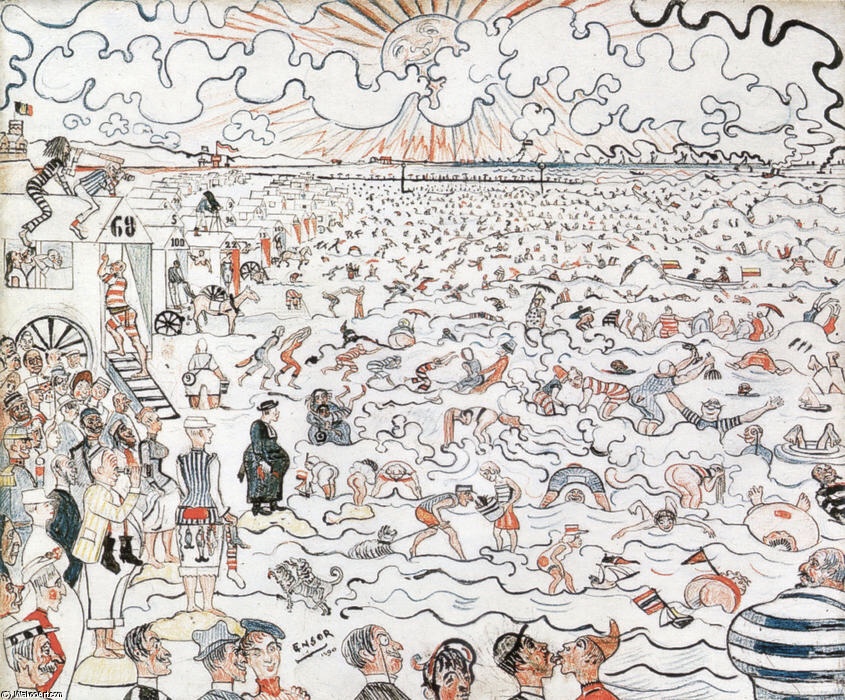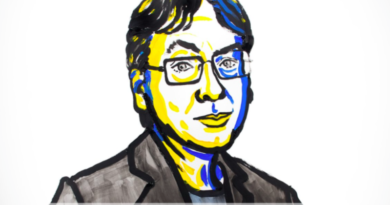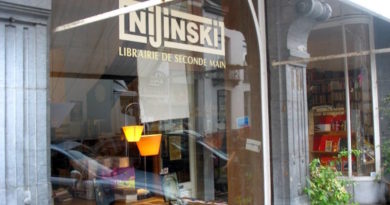James Ensor: The painter of masks who was besotted with Ostend
The garish colours give the impression of joyous vivacity. Until you notice the pale, chalky background and an eerie tension takes hold. The festive attire, the bottle in his hand, untied laces, and violin resting beside him on the floor, all are reminiscences of earlier merrymaking. Apart from the old lady on the left corner of the painting, who seems to be there out of necessity in order to light the room with a candle, raised above her tiny body, there is no reflection of emotions emanating from the others. Masks disguise their identity. Their gaze, hidden behind black holes, locks with the viewer‘s and draws him deeper into the shadow of ostentation and nonchalance.
James Ensor (1860-1949) painted The Strange Masks in 1892, two years before Belgium introduced the universal male suffrage and compulsory voting. There is an aura of quirkiness to Ensor‘s figures that will haunt the viewer long after his encounter with the painting. Angular masks, coarse faces, witch shoes, and mannerist traces of elongated and distorted proportions imbue the atmosphere with suspicion, anguish and foolishness. The Belgian artist had an insatiable appetite for satirical caricatures, along the lines of Otto Dix‘ and Käthe Kollwitz‘ acerbic social criticism.
The crowd is depicted as obedient, with a ravenous lust for the oppressive policies of tyrants or the excitement of recklessness. In The Baths at Ostend (1890), women and men revel in their peculiarity, bathing and playing, undisturbed by the spectators who watch them closely. The compression of figures and the rendition of worldly gaieties echo The Garden of Earthly Delights (1490-1510), a triptych by the Dutch painter Hieronymus Bosch, where temptations and indulgences unfold narratively to display a world of debauchery.

Ensor’s imagery is evocative of unconscious reverberations. Evil physiognomies mirror the power of urges and instincts and the individual‘s propensity towards chaos. A precursor of modern Expressionism, James Ensor disects one’s true identity until the inner evil is laid bare, in all its ugliness. The mask becomes a symbol of the wearer’s wickedness. Carnivalesque and macabre, at the same time. The aesthetic of ugliness exerted an unparalleled influence on the German painter Emil Nolde (1867-1956), who admitted to having been « attracted by decadence, by those who exhaust their lives in the shallow pursuits of pleasure. »
It was his grandmother’s souvenir shop in Ostend, a coastal city in Belgium, that fueled Ensor‘s passion for masks. Gewgaws, shells, mermaids, skeletons, each one a treasure and source of inspiration in the eyes of the small boy who blithely rebelled against the established order. In his work The Intrigue (1890), iridescent masks and flamboyant costumes in Venetian colours invite the viewer into the realm of liminal fantasy, where mystery and vagary become indistinguishable from reality, as in Franz Kafka‘s dreamlike world.

A symphony of light pervades all his compositions. Pearly shells from the shores of the North Sea dissolve into the canvas to give way to « dancing shimmering reflections. » In Pierrot and Skeleton in a Yellow Robe (1893), grinning masks intermingle with translucent layers of colour to dampen gloomy expectations. James Ensor offers a wretched version of reality, always aware of the menacing shadow of vitriol and frustration. He favoured the mask, with its ominous presence and frosty determination, to be his medium of expression. In the words of the French philosopher René Descartes, he would probably have said, « Masked, I advance. » And so, he did.



